The SARS-CoV-2 infection has been spreading widely and rapidly all over the world since the beginning of the year 2020. It is caused by SARS-CoV-2 virus, classified officially by The International Committee on Taxonomy of Viruses [1]. In January 2020, the World Health Organisation (WHO), declared the outbreak to be a ‘Public Health Emergency of International Concern’. WHO also classified it a ‘Pandemic’ on March 11th 2020 [2]. With rising numbers of COVID-19 positive cases, more number of people with severe form were admitted in COVID-19 Intensive Care Unit (ICU) and increasing number of Healthcare Workers (HCWs) were deployed to COVID-19 wards.
This reduced manpower in the remaining areas of the hospital. It became overwhelming for the sparsely staffed burn unit to manage all the burn patients. Nischwitz SP et al., has mentioned that burn patients are at increased risk of acquiring a communicable infection due to their lowered immunity [3]. A strategic approach for the management of burn patients was thus the need of the hour. The biggest challenge was procuring cadaver skin grafts from skin banks due to air travel restrictions [4]. Options for management of extensive burns when there is paucity of donor skin and concomitant restrictions in procurement of alternative cheap biologicals dressings as in a pandemic situation has not been described in literature. The aim of this study is to study the demographic profile of burn patients and describe changes in burn management protocol.
Materials and Methods
This descriptive study was done from March to July 2020, during the COVID-19 pandemic’s initial stages in India, at a tertiary care hospital in Southern India. The study was done after obtaining Institutional Ethical Committee approval (No 236/2020).
Inclusion and Exclusion criteria: All burn patients who visited the hospital’s ER during this period were included in the study. Those patients whose records were incomplete were excluded from the study.
Study Procedure
A total of 77 burn patients visited the emergency during the study period. Epidemiological data for all burn patients were collected. Apart from burn history, detailed documentation was done of patient’s travel history and contact history by HCWs in ER suspect zone wearing level 1 PPE. This included a N95 mask, goggles or face shield, sterile gloves, and protective gown as shown in [Table/Fig-1].
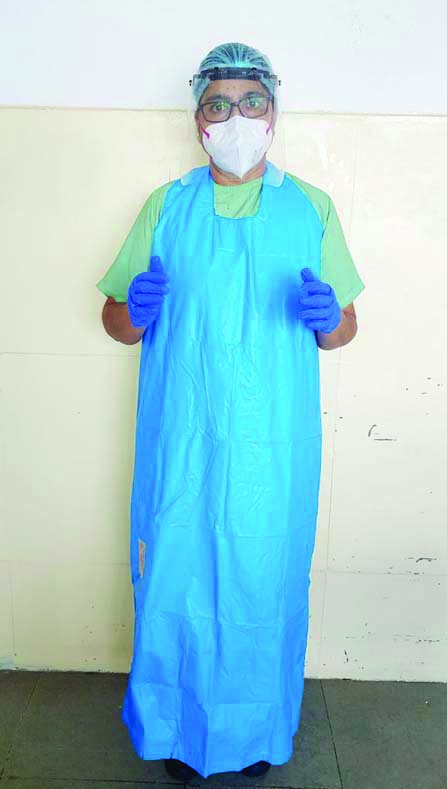
COVID-19 testing by Rapid Antigen Test (RAT) followed by Reverse Transcriptase Polymerase Chain Reaction (RT-PCR) test for negative RAT was done for symptomatic patients or for asymptomatic patients requiring surgery or asymptomatic patients with positive contact history. This was the screening protocol followed as advised by ICMR dated 17/03/2020 (Advisory Strategy of COVID 19 testing in India-Version 2) upto 23/06/2020 (Newer Additional Strategies for COVID-19 Testing) [5,6].
Admission criteria was based on American Burn Association guidelines as followed during pre-COVID-19 times [7]. RAT and RT-PCR negative patients were admitted in burn ward, whereas positive patients were admitted in COVID wards. Total Body Surface Area (TBSA) was calculated from Lund and Browder Chart [8] and burns more than 20% was considered as severe burns. Any surgery for COVID-19 positive patients was done in COVID Operation Theatre (OT) with minimal theatre staff, all wearing level 2 PPE [7]. It consists of head-to-toe moisture repellant gown with N95 mask, sterile gloves and face shield or goggles [Table/Fig-2].
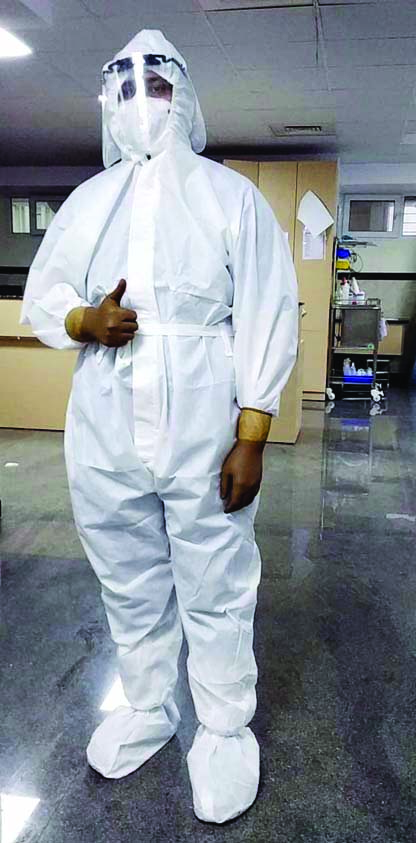
The data about the duration of hospital stay for the patients was collected. Early discharge with reduced hospitalisation was followed. Patients were discharged as soon as graft was well adhered or when there were only small residual raw areas which could be managed by doing home dressings. Patients were given follow-up instructions via teleconsultation where possible or were referred to local doctors/clinics to avoid travel from faraway places.
All HCWs underwent mandatory training in hand wash techniques and in donning and doffing of PPE. HCWs worked in separate teams and in rotation to avoid any cross infection. All patients were seen and examined by HCWs wearing level 1 PPE in ER/ICU/wards. COVID-19 positive patients dressing change and medications were given by HCWs wearing level 2 PPE in COVID-19 ER/wards/ICU.
Statistical Analysis
The data was collected and entered in Microsoft Excel spread sheet and the percentages were calculated.
Results
Seventy-seven burn patients visited the emergency and 44 patients required admission. Total 50% of the admissions were children (i.e., 22 patients). Most of the burns happened at home. More males (47 patients) sustained burns than females (30 patients). More children (40 patients) sustained burns compared to adults (37 patients). Age wise distribution of admitted patients is shown in [Table/Fig-3]. Forty-five patients (58.4%) had sustained scald burns, 23 patients (29.8%) sustained flame burns and 9 patients (11.6%) sustained electric burns. Thirty-two patients had burns upto 20% and 12 patients had burns more than 20%. Sixteen children required paediatric ICU admission and two adults required surgical ICU admission. Remaining 26 patients were admitted to the burns ward. Gender distribution, urban or rural residence details, co-morbidities details and total hospital stay is shown in [Table/Fig-4]. None of the patients were COVID-19 positive during the study period. Among toddlers (0-3 years), 75% required admission, among children in the age group of 4-10 years, 50% required admission and among adults 59.4% were admitted. Burn aetiology, patients requiring surgery and mortality data is shown in [Table/Fig-5].
Age-wise distribution of total patients seen and admitted.
| Age in years | Numbers of patients seen | Numbers of patients requiring admission |
|---|
| 0-3 | 16 (20.78%) | 12 (27.27%) |
| 4-10 | 20 (25.97%) | 10 (22.73%) |
| 11-18 | 4 (5.19%) | Nil |
| 19 and above | 37 (48.05%) | 22 (50%) |
| Total | 77 | 44 |
Demographic details and details of hospital stay.
| Demographic details | Variables | Frequency |
|---|
| Gender | Males | 47 |
| Females | 30 |
| Residence | Urban | 60 |
| Rural | 17 |
| Co-morbidities | Diabetes mellitus | 3 |
| Hypertension | 1 |
| Hospital stay | ≤14 days | 31 |
| ≥15 days | 13 |
Distribution of patients according to aetiology, requiring surgery and mortality.
| Burn aetiology | Scald burn | Flame burn | Electric burn |
|---|
| Patient number | 45 (58.44%) | 23 (29.87%) | 9 (11.69%) |
| Patients requiring surgery (n=9) | 3 (33.33%) | 4 (44.44%) | 2 (22.22%) |
| Mortality (n=2) | 0 | 2 (100%) | 0 |
Following modifications for the management of burn patients were made: Separate areas in the hospital were designated for COVID-19 ER, COVID-19 wards, COVID-19 ICU and COVID-19 OTs. All HCWs examined burns patients in ER wearing level 1 PPE. Safe distance of two metres was maintained between HCWs and patients, except during wound examination and patient interventions. Dressings of COVID-19 positive patients was done by HCWs wearing level 2 PPE. COVID-19 negative patient’s surgeries were done in regular OT. Patients requiring emergency life or limb saving procedures like fasciotomy, escharotomy were not deferred. Those with extensive post burn raw areas underwent delayed grafting after the burn wound bed showed good granulation. Consent to be photographed for scientific and research purposes was taken from all patients.
Care givers were encouraged to always follow social distancing and wear a proper fitting mask. Thirty-three patients had small total burn surface area burns and were advised home dressings. Nine patients underwent surgery for burns. There were no COVID-19 positive patients during the study period. Two children with extensive burns required allograft cover, taken from parents. There were two fatalities- both adults who had extensive flame burns.
Discussion
During the lockdown period in India, 77 patients came to the hospital with burns and more than half of them required to be admitted. Most of these had scald burns which occurred at home. Most patients were from urban areas where homes are small but greater number of people live in them. In crowded homes, there is no luxury of social distancing. In such homes cooking happens at ground level or on narrow ledges. With outdoor movements limited, the cramped home situation has increased chances of people, especially children, sustaining accidental burns. Also, during the lockdown, childcare facilities were closed and the entire responsibility was on parents who had to manage the house and attend to work calls simultaneously. Such a perilous situation coupled with congested homes was a disaster waiting to unfold. Majority of burns were seen in children requiring admission, indicating these were major burns. Peadiatric scald burns increasing during lockdown period in India was also seen in a study done by Kakar A and Nundy S, [9]. A study by Kawalec AM in a paediatric hospital in Poland in March 2020 also showed more children sustained burns during the lockdown period in that country. This was three times higher than in February 2020 when lockdown was not yet imposed in Poland. The author attributed this rise in paediatric burn to parents being unable to supervise children continuously as they also had to work from home. The author also noted that scald burns remained the leading type of burns in COVID and pre COVID times [10].
Total of nine patients were operated upon. Five patients underwent tangential excision and autografting. Two patients underwent debridement and autografting. Two paediatric patients with extensive burns required cadaver skin grafts for wound cover following tangential excision and wound debridement. Since skin banks were closed nationwide due to the lockdown, grafts were harvested from parents after taking informed consents. Paediatric burn wound was covered over multiple stages using allograft skin from parents followed by autograft for the reduced final raw areas is shown in a series of pictures from [Table/Fig-6,7,8,9,10,11,12 and 13]. Surgery was done only where it was necessary and with minimal theatre staff to prevent any exposure risk to and from patient and concerned operation theatre staff [11]. Personnel movement in and out of operating rooms was restricted. COVID-19 positive patient’s surgeries were to be done wearing level 2 PPE in COVID-19 designated theatres. No life or limb saving procedures was deferred. Postoperative dressing changes was done using level 1 protection for non COVID cases and level 2 PPE for COVID cases. Early discharge was the aim for all admitted patients. Majority of the patients were discharged within two weeks of admission.
A 10-year-old child with 44% flame burns at 3 weeks post burns showing eschar over the entire anterior trunk.
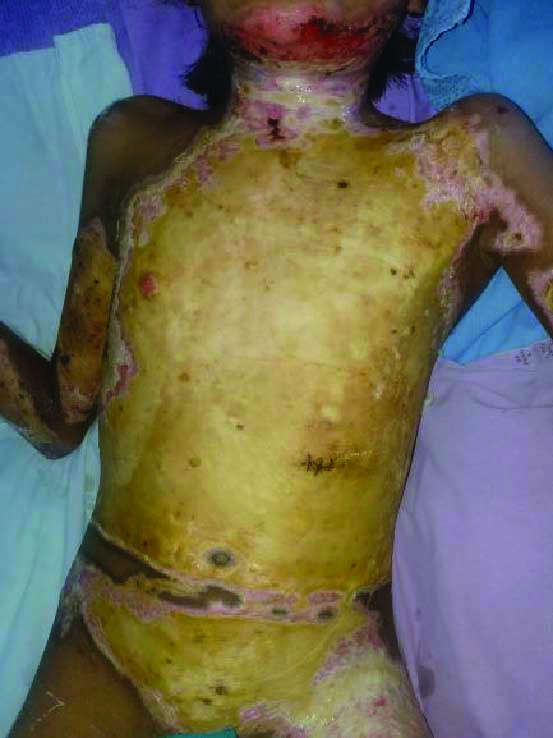
At five weeks post burns showing debridement in OT of loose eschar on anterior trunk.
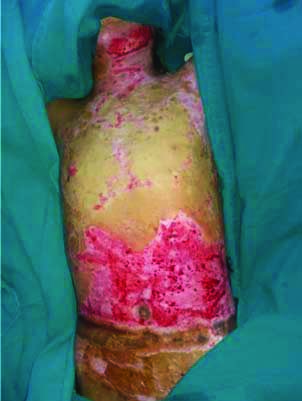
At seven weeks post burns showing further separation of eschar over anterior chest with gradual loss of allograft (from parent- father) applied over lower abdomen.
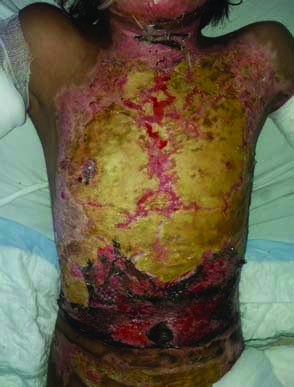
At 10 weeks post burns showing debridement of anterior trunk in OT.
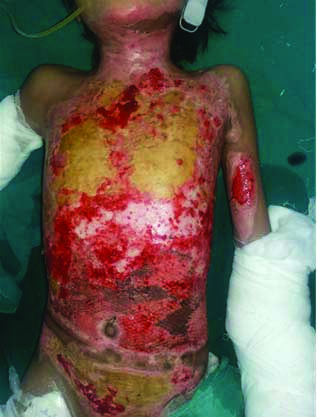
At week 11 showing applied allograft (from parent-father) over anterior chest with autograft + allograft (sandwich technique) over abdomen area.
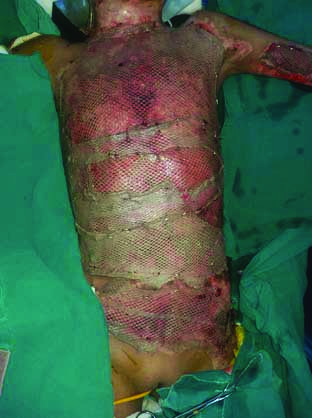
At week 13 showing loss of allograft over anterior chest, good take of autograft over abdomen area.
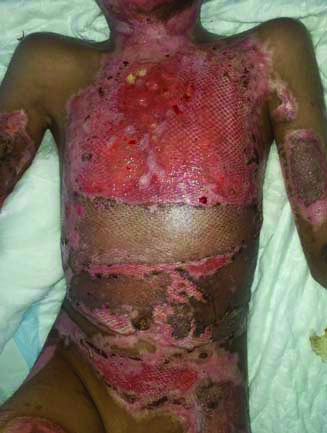
At 14 weeks showing application of autograft over anterior chest area.
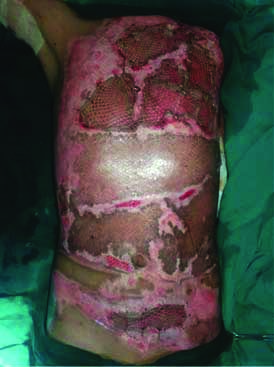
At 15 weeks showing fully healed anterior trunk.
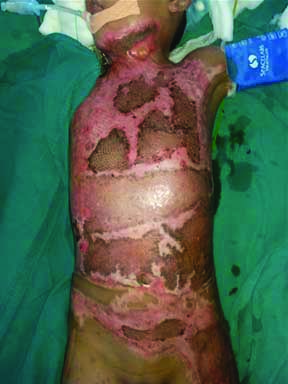
Some measures were undertaken in the hospital to prepare for receiving of COVID-19 patients. Training was given by the infection control team to HCWs on hand hygiene and donning and doffing of level 2 PPE (full length fluid repellant gown). HCWs worked in separate teams and in rotation to avoid any cross infection. Burns ward rooms were regularly cleaned and sterilised as per the hospital’s infection control protocol. Separate areas in the hospital were identified as COVID-19 ER, wards, ICU and OTs to receive and treat suspected and positive COVID-19 patients. These modifications had been followed in other major hospitals in India dealing with COVID-19 and burn patients [12,13]. Barret JP et al., in an international multicentric study described that in Birmingham (University Hospitals Birmingham) and Barcelona (Valld’Hebron Hospital Campus) similar strategies with minimum hospital staff and designated COVID-19 positive areas were followed. Whereas in Singapore and Tokyo not many changes were made as these countries have prior experience with similar emergency situations and could handle such cases on a short notice [14].
The following measures were undertaken to reduce the risk of virus transmission in ER. All burn patients arrived at ER suspect area where patient’s and caregiver’s body temperature were checked. History of travel, contact and respiratory symptoms were taken from both by HCWs wearing level 2 protective gear. If patient was febrile on arrival or had positive history, it was recommended to shift the patient to COVID positive area. ICMR and institution guidelines recommend doing RT-PCR test for these patients [5,6]. Burn wound examination was done by HCWs wearing level 2 PPE. If patient was afebrile with negative history, patient was moved to COVID negative areas. Here burn wound assessment was done by HCW wearing level 1 protective gear. Strictly one patient, one caregiver ratio was maintained, and both had to compulsorily wear a mask. Ma S et al., have also mentioned the importance of decreasing the number of caregivers per patient [15]. Burn wound percentage was calculated based on Lund and Browder Chart. Patients with minor burns were advised to do dressings at home and follow-up via teleconsultation where possible or to visit OPD at infrequent intervals [13]. Burn patients with larger wounds and negative history were admitted to the isolated single rooms in the burn ward or in surgical ICU whereas burn patients with positive symptoms or history were admitted to an isolated single room in COVID ward or in COVID ICU. COVID-19 dressings were to be done wearing level 2 PPE. For patients with associated inhalation injury, airway lavage and sputum suctioning was to be minimised and done wearing level 2 PPE [15]. None of the admitted burn patients in the study period were COVID-19 positive. Similar study done in an Austrian Hospital also had no COVID-19 positive burn patients during their lockdown period [3].
The following measures were undertaken to be vigilant of patients developing COVID-19 symptoms during course of hospital stay. Along with the patient’s vitals, saturation levels on room air were compulsorily recorded at regular intervals. Routine chest imaging was not done for asymptomatic patients, unless needed as preoperative evaluation or if there was a suspicion of inhalational injury. Similar guidelines were followed in one of the largest hospitals in Austria which catered to burn patients during the pandemic [3]. This contrasted with hospitals in Shanghai where chest imaging was done for all patients, even asymptomatic. In another hospital in Chongqing, chest imaging was done for suspects and patients of unknown status [14,15]. Change of caregiver was not allowed during the entire time of admission of these patients. Ma S et al., mentioned that caregiver cannot be a COVID-19 diagnosed patient or a suspect [15]. Visitors were completely suspended for the entire duration of admission [16]. Fever is a common feature seen in burn patients, especially with larger burns. If fever was accompanied with cough, referral was given to the chest medicine department and chest CT, RT-PCR tests were done where indicated [15].
At every follow-up visit patient and caregiver’s body temperature was checked. In OPD medical workers wore level 1 PPE. Handwashing was mandatorily carried out between patients and unnecessary contact with patients was avoided. If burn wound exudate was less, dressing change was done once in 2-3 days as advised by Ma S et al., [15]. This reduced the number of hospital visits and exposure risk for the patient, caregiver and HCWs. Rehabilitation was taught by burn HCWs with limited visits to the hospital. The importance of social distancing and wearing a mask covering nose and mouth while outdoors was stressed upon to prevent spread of the infection [11,17]. Video consultation follow-up was encouraged. Any patient requiring an elective procedure like contracture release or intralesional steroid injections were postponed to a later date after recession of the pandemic [3,15].
Limitation(s)
As only symptomatic cases or those who required surgery were tested for COVID-19, it is possible that asymptomatic burn cases being COVID-19 positive may have been missed out. Our experience with intraoperative COVID-19 burn management is modest as we did not have positive patient in the study duration. This study however highlights the preparedness and changes required to handle burn patient s during a pandemic.
Conclusion(s)
In this study, children seem to be more vulnerable to domestic burn injuries. Awareness of this issue and vigilant supervision of children always is of utmost importance. First aid and home dressings of burns should be encouraged by teaching wound care to caregiver. Only critically burnt patients and those patients who cannot be managed at home should be admitted. Level 1 PPE was used compulsorily in hospital during COVID-19 negative patient care. level 2 PPE was used for dressings and surgeries of COVID positive patients. All life and limb saving surgeries were done. Burn wound surgeries were done with minimal OT staff. Live skin donor was used in case of paucity of cadaver skin during a pandemic. Early discharge of patients was done. Follow-up and physiotherapy was done through teleconsultation. It was recommend to wear a proper fitted mask and social distancing as all countries were going through multiple waves of COVID-19 pandemic.